Long-term hypoxia enhances ACTH response to arginine vasopressin but not corticotropin-releasing hormone in the near-term ovine fetus
- PMID: 19625690
- PMCID: PMC2739789
- DOI: 10.1152/ajpregu.00220.2009
Long-term hypoxia enhances ACTH response to arginine vasopressin but not corticotropin-releasing hormone in the near-term ovine fetus
Abstract
This study tested the hypothesis that long-term hypoxia (LTH) results in enhanced fetal corticotrope sensitivity to the ACTH secretagogues, corticotropin-releasing hormone (CRH), and AVP. Ewes were maintained at high altitude (3,820 m) from 40 to 130-131 days of gestation. Upon return to the laboratory, hypoxia was maintained by maternal nitrogen infusion. Vascular catheters were placed in both LTH (n = 4) and normoxic controls (n = 4). Each fetus received a 15-min infusion of either saline, 100 ng/kg of ovine CRH, or 20 ng/kg of AVP/min over 3 consecutive days in a randomized order. Fetal blood samples were collected at 0, 15, 30, 60, and 90 min after the start of infusion and analyzed for ACTH(1-39), ACTH precursors, and cortisol. Anterior pituitaries were collected from additional noninstrumented fetuses for analysis of vasopressin receptor 1b (V1b) mRNA and protein. Basal plasma concentrations of both ACTH(1-39) and ACTH precursors were higher in LTH fetuses and were not altered by saline infusion. In response to CRH, ACTH(1-39) increased in both groups and was higher in the LTH group compared with control (P < 0.05). When analyzed as sum of ACTH(1-39) released (Delta0-90 min) above basal, CRH released equal amounts of ACTH(1-39) in both groups. In LTH fetuses, AVP evoked a greater ACTH(1-39) release (P < 0.05) when analyzed as an increased sum of ACTH(1-39) (Delta0-90 min) above basal. Both CRH and AVP elicited a release of ACTH precursors with no differences observed between LTH and control. AVP and CRH elicited significant increases in cortisol, which were higher in response to AVP than CRH. V1b mRNA and protein were elevated in the anterior pituitary of LTH fetuses compared with control. LTH significantly increases pituitary sensitivity to AVP. This enhanced sensitivity may be a mechanism of our previously observed enhanced corticotrope function.
Figures

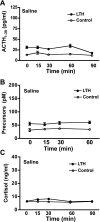
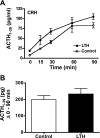
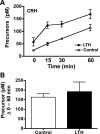
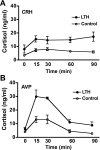
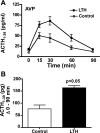
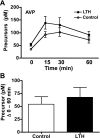
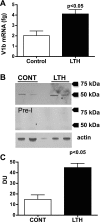
Similar articles
-
Gestational hypoxia modulates expression of corticotropin-releasing hormone and arginine vasopressin in the paraventricular nucleus in the ovine fetus.Physiol Rep. 2016 Jan;4(1):e12643. doi: 10.14814/phy2.12643. Physiol Rep. 2016. PMID: 26733242 Free PMC article.
-
Long-term hypoxia enhances proopiomelanocortin processing in the near-term ovine fetus.Am J Physiol Regul Integr Comp Physiol. 2005 May;288(5):R1178-84. doi: 10.1152/ajpregu.00697.2004. Epub 2004 Dec 23. Am J Physiol Regul Integr Comp Physiol. 2005. PMID: 15618345
-
The effects of fetal adrenalectomy at 110 days gestational age on AVP and CRH mRNA expression in the hypothalamic paraventricular nucleus of the ovine fetus.Brain Res Dev Brain Res. 1998 Mar 12;106(1-2):119-28. doi: 10.1016/s0165-3806(97)00203-4. Brain Res Dev Brain Res. 1998. PMID: 9554977
-
Maternal and fetal hypothalamic-pituitary-adrenal axes during pregnancy and postpartum.Ann N Y Acad Sci. 2003 Nov;997:136-49. doi: 10.1196/annals.1290.016. Ann N Y Acad Sci. 2003. PMID: 14644820 Review.
-
Vasopressin and the regulation of hypothalamic-pituitary-adrenal axis function: implications for the pathophysiology of depression.Life Sci. 1998;62(22):1985-98. doi: 10.1016/s0024-3205(98)00027-7. Life Sci. 1998. PMID: 9627097 Review.
Cited by
-
Adrenocorticotropic Hormone and PI3K/Akt Inhibition Reduce eNOS Phosphorylation and Increase Cortisol Biosynthesis in Long-Term Hypoxic Ovine Fetal Adrenal Cortical Cells.Reprod Sci. 2015 Aug;22(8):932-41. doi: 10.1177/1933719115570899. Epub 2015 Feb 5. Reprod Sci. 2015. PMID: 25656500 Free PMC article.
-
Adrenocortical and adipose responses to high-altitude-induced, long-term hypoxia in the ovine fetus.J Pregnancy. 2012;2012:681306. doi: 10.1155/2012/681306. Epub 2012 May 14. J Pregnancy. 2012. PMID: 22666594 Free PMC article. Review.
-
Expression of StAR and Key Genes Regulating Cortisol Biosynthesis in Near Term Ovine Fetal Adrenocortical Cells: Effects of Long-Term Hypoxia.Reprod Sci. 2018 Feb;25(2):230-238. doi: 10.1177/1933719117707056. Epub 2017 May 3. Reprod Sci. 2018. PMID: 28468567 Free PMC article.
-
Long-term hypoxia enhances cortisol biosynthesis in near-term ovine fetal adrenal cortical cells.Reprod Sci. 2011 Mar;18(3):277-85. doi: 10.1177/1933719110386242. Epub 2010 Nov 15. Reprod Sci. 2011. PMID: 21079237 Free PMC article.
-
Gestational hypoxia modulates expression of corticotropin-releasing hormone and arginine vasopressin in the paraventricular nucleus in the ovine fetus.Physiol Rep. 2016 Jan;4(1):e12643. doi: 10.14814/phy2.12643. Physiol Rep. 2016. PMID: 26733242 Free PMC article.
References
-
- Adachi K, Umezaki H, Kaushal KM, Ducsay CA. Long-term hypoxia alters ovine fetal endocrine and physiological responses to hypotension. Am J Physiol Regul Integr Comp Physiol 287: R209–R217, 2004. - PubMed
-
- Behan DP, De Souza EB, Lowry PJ, Potter E, Sawchenko P, Vale WW. Corticotropin-releasing factor (CRF) binding protein: a novel regulator of CRF and related peptides. Front Neuroendocrinol 16: 362–382, 1995. - PubMed
-
- Bell ME, Myers TR, Myers DA. Expression of proopiomelanocortin and prohormone convertase-1 and -2 in the late-gestation fetal sheep pituitary. Endocrinology 139: 5135–5143, 1998. - PubMed
-
- Carr GA, Jacobs RA, Young IR, Schwartz J, White A, Crosby S, Thorburn GD. Development of adrenocorticotropin-(1–39) and precursor peptide secretory responses in the fetal sheep during the last third of gestation. Endocrinology 136: 5020–5027, 1995. - PubMed
-
- Castro MI, Valego NK, Zehnder TJ, Rose JC. The ratio of plasma bioactive to immunoreactive ACTH-like activity increases with gestational age in the fetal lamb. J Dev Physiol 18: 193–201, 1992. - PubMed
Publication types
MeSH terms
Substances
Grants and funding
LinkOut - more resources
Full Text Sources
Miscellaneous

